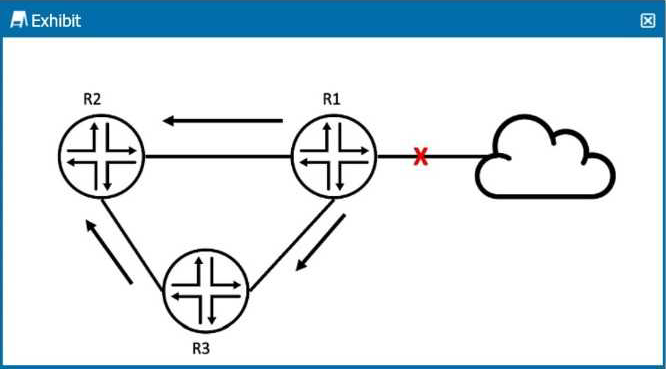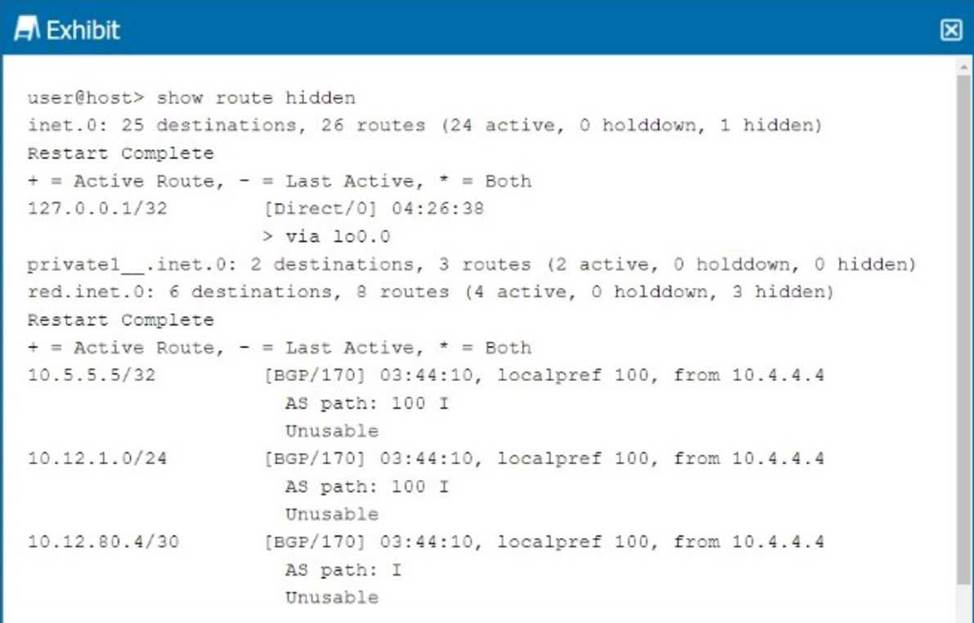Practice Free JN0-280 Exam Online Questions
Which statement about switches is correct?
- A . Each port is a member of VLAN 2 by default.
- B . Every port is in a unique collision domain.
- C . Each port is in a unique broadcast domain by default.
- D . All ports reside in the same collision domain.
B
Explanation:
Each port on a modern switch creates a separate collision domain. This allows multiple devices to communicate simultaneously without collisions on different ports.
Step-by-Step Breakdown:
Collision Domain:
A collision domain is a network segment where data packets can collide if two devices send packets simultaneously.
On a switch, each port creates a separate collision domain, so collisions only occur if two devices connected to the same port (through a hub, for instance) try to send data at the same time. Switches vs Hubs:
Unlike hubs, which have one large collision domain, switches isolate collisions to individual ports,
improving performance.
Juniper
Reference: Switch Port Behavior: In Juniper switches, each port operates in its own collision domain, enhancing network efficiency by reducing the chances of packet collisions.
Exhibit:

R2 received an OSPF update from R1, and it received the same update from R3.
Referring to the exhibit, what will R2 do?
- A . R2 ignores the update from R1.
- B . R2 does nothing with R3’s update.
- C . R2 ignores the update from R3.
- D . R2 acknowledges R3 and discards it.
C
Explanation:
In the exhibit, R2 receives the same OSPF update from both R1 and R3. OSPF has mechanisms to prevent unnecessary processing of duplicate LSAs (Link-State Advertisements).
Step-by-Step Breakdown:
OSPF LSA Processing:
OSPF uses LSAs to exchange link-state information between routers. When a router receives an LSA, it checks if it already has a copy of the LSA in its Link-State Database (LSDB).
Duplicate LSAs:
If R2 has already received and processed the update from R1, it will ignore the update from R3 because it already has the same LSA in its database. OSPF uses the concept of flooding, but it does not reprocess LSAs that it already knows about.
R2 Behavior:
R2 will keep the update from R1 (the first one it received) and will ignore the same LSA from R3, as it
is already in the LSDB.
Juniper
Reference: OSPF LSA Processing: Junos adheres to OSPF standards, ensuring that duplicate LSAs are not processed multiple times to avoid unnecessary recalculations.
What is the main purpose of Bidirectional Forwarding Detection (BFD)?
- A . to detect network path failures
- B . to determine if the forwarding routes are correct
- C . to detect the forwarding protocol
- D . to determine packet round-trip latency
A
Explanation:
Bidirectional Forwarding Detection (BFD) is a network protocol used to detect failures in the network path between two devices quickly.
Step-by-Step Breakdown:
Path Failure Detection:
BFD provides a low-overhead mechanism for detecting failures in forwarding paths across Layer 3 networks. It is much faster than traditional routing protocol timers and can detect failures within milliseconds.
BFD in Routing:
BFD can be integrated with routing protocols like OSPF, BGP, or IS-IS to trigger a faster convergence when a network path goes down.
Juniper
Reference: BFD Configuration: Juniper devices use BFD to monitor network paths and ensure fast failure detection, enhancing network resilience.
When using spine and leaf fabric architectures, what is the role of each device? (Choose two.)
- A . Spine nodes are used for host connectivity.
- B . Spine nodes are used for transit to other leaf nodes.
- C . Leaf nodes are used for traffic to other leafs.
- D . Leaf nodes are used for host connectivity.
B, D
Explanation:
In a spine-leaf fabric architecture, which is commonly used in data center designs, each device has a distinct role to ensure efficient and scalable network traffic flow. Step-by-Step Breakdown:
Spine Nodes:
The spine nodes form the backbone of the fabric and are responsible for transit traffic between leaf
nodes. They connect to every leaf switch and provide multiple paths for traffic between leaf nodes,
ensuring redundancy and load balancing.
Leaf Nodes:
The leaf nodes are used for host connectivity. These switches connect to servers, storage, or edge routers. They also connect to the spine switches to reach other leaf switches. Juniper
Reference: Spine-Leaf Architecture: In Juniper’s IP fabric designs, spine switches handle inter-leaf communication, while leaf switches manage host and endpoint connectivity.
Which two statements describe an OSPF ABR? (Choose two.)
- A . By default, an ABR does not need to have any links in the backbone area.
- B . By default, an ABR is an OSPF router with links in two areas.
- C . By default, an ABR is an OSPF router with all of its links in one area.
- D . By default, an ABR must have one link in the OSPF backbone area.
When troubleshooting an OSPF neighborship, you notice that the router stopped at the ExStart state.
What is the cause of this result?
- A . The priority is set to 255.
- B . There is an interval timing mismatch.
- C . There is an area ID mismatch.
- D . There is an MTU mismatch.
D
Explanation:
When an OSPF (Open Shortest Path First) neighborship is stuck in the ExStart state, it usually points to a mismatch in Maximum Transmission Unit (MTU) settings between two routers trying to establish the adjacency. The ExStart state is where OSPF routers negotiate the master-slave relationship and exchange DBD (Database Description) packets.
Step-by-Step Breakdown:
OSPF Neighbor States: OSPF goes through several states to establish an adjacency with a neighbor:
Down: No hello packets have been received.
Init: Hello packets are received, but bidirectional communication isn’t confirmed.
2-Way: Bidirectional communication is established.
ExStart: The routers are negotiating who will be the master and who will be the slave, and begin to exchange DBD packets.
Exchange: The routers start exchanging the database information.
Loading: The routers process the Link-State Advertisements (LSAs).
Full: The adjacency is fully established.
MTU Mismatch Issue:
During the ExStart state, both OSPF routers must agree on their MTU values. If there is an MTU mismatch between the two routers, OSPF neighbors will fail to move from the ExStart to the Exchange state. The router with the larger MTU setting will not accept DBD packets from the router with a smaller MTU because the packets may exceed the smaller MTU size.
In Juniper devices, this behavior can be identified by examining the MTU settings using the show interfaces command and ensuring both routers have matching MTU configurations. To resolve this issue, either match the MTU settings on both routers or configure OSPF to ignore MTU mismatches
using the command set protocols ospf ignore-mtu.
Juniper
Reference: Junos Command: show ospf neighbor helps diagnose neighbor states.
MTU Adjustment: set interfaces <interface-name> mtu <size> can be used to set the MTU values correctly.
Which EBGP feature must be used when peering to a non-directly connected peer address?
- A . multihop
- B . AS path
- C . local preference
- D . multipath
Referring to the exhibit, why are the BGP routes hidden?

- A . Load balancing is not enabled.
- B . There are too many hops to the destination.
- C . The BGP next hop is unreachable.
- D . Other routes are selected because of better metrics.
C
Explanation:
In the exhibit, the BGP routes are marked as hidden. This typically happens when the routes are not considered valid for use, but they remain in the routing table for reference. One common reason for BGP routes being hidden is that the next hop for these routes is unreachable.
Step-by-Step Breakdown:
BGP Next Hop:
In BGP, when a route is received from a neighbor, the next hop is the IP address that must be reachable for the route to be used. If the next hop is unreachable (i.e., the router cannot find a path to the next-hop IP), the route is marked as hidden. Analyzing the Exhibit:
The exhibit shows that the BGP next hop for all hidden routes is 10.4.4.4. If this IP is unreachable, the BGP routes from that neighbor will not be considered valid, even though they appear in the routing table.
Verification:
Use the command show route 10.4.4.4 to check if the next-hop IP is reachable.
If the next-hop is not reachable, the BGP routes will be hidden. Resolving the next-hop reachability issue (e.g., fixing an IGP route or an interface) will allow the BGP routes to become active. Juniper
Reference: Junos Command: show route hidden displays routes that are not considered for forwarding. Troubleshooting: Check the next hop reachability for hidden BGP routes using show route <next-hop>.
You are configuring OSPF in your network as shown in the exhibit. R1 has been configured with interface metrics. All other links in the network are using the default interface metric.
In this scenario, which OSPF interface on R1 will be preferred when routing traffic between R1 and R5?

- A . ge-0/0/0
- B . ge-0/0/3
- C . ge-0/0/1
- D . ge-0/0/2
In configuring load balancing on a network router, which aspect is most crucial?
- A . The encryption protocol used
- B . The number of routing tables
- C . The selection of multiple equal-cost paths
- D . The use of aggregate routes
